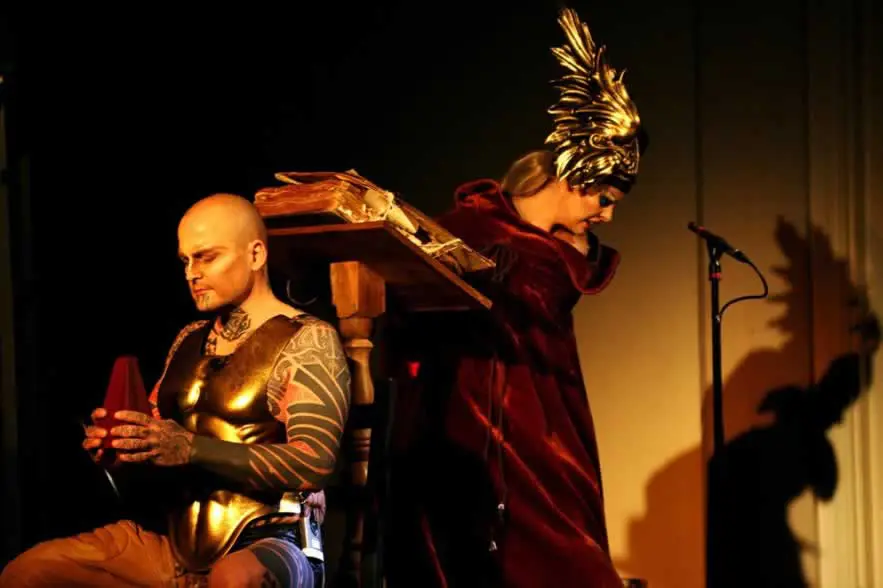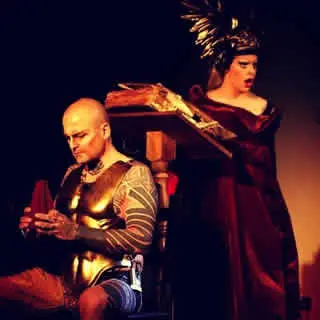Work
The Judas Cradle (2004—2008)
The Judas Cradle, one of the most provocative pieces of live art ever staged, was conceived, directed and performed by Juliana Snapper and Ron Athey. The costumes were designed by Suzette Matheson.
Allowing for a “rupture of the habitus”, the experience began in 2004 (Cetrone Studio, Los Angeles, CA, USA; REDCAT/Disney Concert Hall, Los Angeles, CA, USA; Performa 05 at Participant Inc, New York City, NY, USA, etc.).
Audio excerpts from The Judas Cradle
Listen to excerpts from The Judas Cradle performances by Juliana Snapper and Ron Athey:




Among other places —Aksioma Festival, Ljubljana, Slovenia (Dec. 2004), Rouyn-Noranda, Quebec, CA (Sept. 2008)…— the work was notably performed in Manchester, England (May 2005), as part of the international 2005 Fierce! Festival (see below: The Judas Cradle ’s 2005 British Isles tour).
Video excerpts from The Judas Cradle
▢ Behind the scenes
The Judas Cradle, an interactive DVD film directed by Lisa Cazzato-Vieyra and Manuel Vason (2006), goes behind the scenes of The Judas Cradle 2005 Fierce! Festival performances. Watch excerpts from this documentary:
▢ Singing upside down
“ We had a hell of a time trying to get my voice to break down under stress. We had me folding over jungle gym bars and contorting every which way before discovering that hanging upside down, with a slight arch to the back, will undo the vocal mechanism over the course of several minutes. ”
“ I like struggling with a mastery that is no longer fully relevant (bel canto) and having to transform it into something else again and again. (…) Singing upside down was emotionally taxing. Maybe because your heart and head fill with blood, or for the way that failure happens gradually. ” (Juliana Snapper’s verbatim)
Rupturing the Habitus?
Prof. Amelia Jones reflects on radical performance art that thrives on the repetition of rigid rules of habit, inscribed on highly trained bodies, like opera. The Judas Craddle —“its relentless and savagely violent and beautiful dehabituations of the bodies”, as she elaborates— strives precisely to engage with these “habituated” art forms by repeating them with… “savage difference”:
“ Performance artist Ron Athey and opera singer Juliana Snapper violently dehabituate the sexually and occupationally normative body. (…) Snapper deliberately dehabituates her opera-trained body by hanging upside down on a rack. Her diaphragm pushing downward into her lungs, her voice becomes strangled. She suffers a kind of martyrdom to her body, which drips downward like the flayed flesh of Marsyas. Gulping and howling like a strangled dog, she articulates a human pain that is at once both ‘universal’ (in that everyone can and probably has felt it) and of the utmost social and political and embodied specificity (each experience of it is unique and unextrapolable).
Estranged from its training, Snapper’s opera body is made deliberately wrong and calls forth my inexorable sense of absolute wrongness (something I experience multifold a million times a day in the aches and pains of a stress-wracked body that dehabituates itself, over and over again, from the vicissitudes of everyday life).
This example suggests that the format and contexts of performance art (for surely, Snapper would not dehabituate her body in such a way in an opera!) can alllow for a rupture of the habitus that binds us to normativity while also making expertise possible. (…)
And yet Athey’s extreme actions and Snapper’s distorted opera body suggest that the context of performance art offers possible ways of refusing what Bourdieu called our expected ‘conditions of existence’, through embracing the missed timing of ‘dispositions ill-adjusted’ to existing bodily forms and existing environments (…). Breaking habits may be one of the most interesting ways to misbehave, producing potentially new modes of embodiment that - at least momentarily - escape the constrictions of the habitus. ”
“The Voice of Death, Rupturing the Habitus”,
Amelia Jones & Marin Blažević,
Performance Research,
Volume 19, 13 Aug 2014 - Issue 3
Performa 05: The Judas Cradle (an excerpt for SCOUT)
A SCOUT literary performance curated by Eileen Myles
For the first Biennial of Visual Art Performance, Performa 05, on Nov. 17, 2005 (NYC, NY), Juliana Snapper and Ron Athey, using vocal material developed for their opera The Judas Cradle, gave a special performative gallery recital “teasing the space between sickness and sparkle.”
SCOUT was an ongoing literary and performance event series curated by writer Eileen Myles.
Performa 05/Participant Inc was curated by Lia Gangitano.



▢ Juliana Snapper’s verbatim on the Performa 05 show presentation text
“ Ron and I wrote this text after many months of training followed by a X-city tour of England, Ireland and Scotland, and finally home to LA.
Some audiences, especially in the UK, had emerged from our show dissatisfied — some because they had expected blood to spill and others because the “opera” was violent, and offered no melodies to hum on the way home.
This is our parallel effort to describe the piece before taking her to New York. ”
JULIANA — Ron’s voice is so tender and lovely but there is also something wrong. It’s so moist and fluid… until it scrapes and withdraws like a snail covered in sores. I am his pavement, hardened and consistent but cracking from the slow push of weedy sounds. I’m constantly fishing out his sneak-secret lyricism with my own. Sometimes he makes me a glowing midwife and other times I’m a blind obstetrician yanking on a hemorrhoid crying, “Push!”
RON — During a very serious reconstruction of a notorious trial from the Spanish Inquisition mid-way into The Judas Cradle, I leave the stand and break into some childish fake tap-dancing, while vocally punching out Jean Genet’s closing text from his memoir, Prisoner of Love: “The witness doesn’t merely answer the implicit question ‘how?’ — in order to show the ‘why’ he throws light on the ‘how,’ a light sometimes called artistic… He knows a realistic description won’t mean anything to anyone, … unless he adds some light and shade which only he perceived.”
JULIANA — Ron’s tap shoes don’t have heels—it’s like Grandpa ran away from the rest home for entertainers. I’m trying to get him to tap in time by barking like a seal and banging my staff in polyrhythms that collapse before they can get groovy.
RON — The Judas Cradle opens with a duet that misleads with a rigid formality: we misuse Turandot’s riddle to establish our character and sound. Slowed down, we run the questions of the riddle into the answers, disregarding the punchline. Stance, armor, a commitment to monotony — we’re sincere. It’s the high artifice and bloat of opera that becomes iconoclastic.
JULIANA — I’m panting after a simple climb up six stairs because my ribcage is smashed by whalebone and rope and I’m dragging twenty-two pounds of drapery from Leigh Bowery’s closet. I press my ribs apart and suck my uvula into my sinuses. I never quite catch my breath, but enter the duet Ron has set off with a wolfish howl.
RON — Sincere to a point. How can you quote Puccini, Bellini, and Debussy without throwing in a few cans of Crisco? In the scene “Sextette,” Juliana develops a circular rhythm of moans and purrs with a little help from Mae West, and we begin alternately showboating. I construct a set of grease-filled breasts for myself and, feeling the need once again to deflate the bloat, do a clunky stripper floor-work slide across the room, leaving a fairly perfect snail trail behind.
JULIANA — We composed The Judas Cradle through a series of alchemical processes uncovered during a year of toil in our voice lessons–turned–laboratory, which was sometimes the lap of a baby grand and other times this piss-soaked underground echo chamber. Singing is just a gassy tentacle with no respect for borders like skin. It sneaks in and out of you, makes you remember memories that aren’t yours and want things you never used to want. It shares a crossfire of sordid empathies with interrogation, hysteria, and possession, and also the real possibility of overlap.
RON — It was not the act, but the concept of singing a duet with a highly trained, flawless soprano. My voice, a decrepit tenor with no singing experience, seemed impossible to work with (to me). I found my voice by becoming a ghost of hers, following her voice up and down and into a sound world of invasive resonance. Phonetically memorizing Italian and French arias proved a challenge, but eventually they stuck. The only bit that was not out of my realm was the closing duet, “Autodafe.” In this scene we take up glossolalia, a spastic speaking-in-tongues I received during my Pentecostal childhood. Trying to find a way to interact, we eventually developed a technique to tag-team chaos. Always starting in silent tremors the struggle went beyond psychotic outburst, became a wordless dialogue that not only conjured ecstasy, dementia, and exorcism: these states became innate.
The intent of The Judas Cradle, at least in part, was to take on the role of witnessing. Responding, trying to discern a logic to the horrors of the day, we absorbed photographs and manuals of torture and interrogation. It’s opera that we fetishized, not torture. I deviate and stage a reversal, climbing a ladder to mount the Judas cradle, a medieval structure orchestrated to be a kinder, gentler form of torment. My body becomes almost epileptic as its weight forces the tip of the wooden pyramid into my rectum. No longer the witness, I send my voice into a soft tenor and let an Italian art song whine and crumble out of me: Malinchonia, ninfa gentile…
JULIANA — I’m suspended by my ankles, flailing, struggling to communicate, fighting the dissociative weight of gravity. Oh, I am a flat thing pressing hard on some slime. I press out cadenzas until my voice comes undone. I sing until my diaphragm sags inert, my vocal chords refuse to adduct, my ears ring and my eyelids are peppered with pore-size bruises from hanging too long.
Photos from The Judas Cradle performances






The Judas Cradle ’s 2005 British Isles tour
- 5-7 May: Granary Theatre, Mardyke, Cork City, Ireland
- 12 May: Colchester Arts Centre, Colchester, England
- 14 May: Chapter Arts Centre, Cardiff, Wales
- 17 May: Contact Theatre, Manchester, England (presented as part of Queer up North Festival)
- 19-20 May: 291 Gallery, Hackney, London, England
- 26-27 May: Warwick Arts Centre, Coventry, England
- 1-2 June: CCA, Glasgow, Scotland
